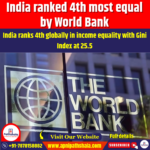17th BRICS Summit 2025
General Studies Paper II: Important International Institutions, Groupings & Agreements Involving India and/or Affecting India’s Interests |
Why in News?
Recently the 17th BRICS Summit took place in Rio de Janeiro from July 6–7 2025. The bloc added new members and called for global South empowerment. In this summit, leaders emphasized multilateralism and economic reform while condemning tariff hikes and Middle East violence.
Key Highlights of 17th BRICS Summit 2025
- The 17th BRICS summit took place in Rio de Janeiro from July 6 to 7, 2025.
- Brazil hosted the expanded BRICS summit in 2025 with the theme “Inclusive and Sustainable Global South.”
- Eleven full member countries attended this summit along with new member countries.
- This enlargement increased BRICS representation to over half of the global population.
- The summit renewed calls to reform global institutions like the UN Security Council, IMF, and World Bank.
- Members also pushed for fairer representation in global decision-making.
- Leaders called for a new climate‑focused fund called the Tropical Forests Forever facility.
- China and UAE pledged support for this green initiative under Brazil’s proposal.
- BRICS introduced a initiative through the New Development Bank to make project loans more affordable.
- Member countries confirmed their commitment to local currency trade and payment systems to boost economic independence.
- Leaders condemned unilateral military attacks in Gaza and strikes on Iran as violations of international law.
- They emphasized support for a two‑state solution for Palestine and urged restraint in the Middle East.
- The summit also spotlighted AI governance and data protection policies. They supported rules for fair compensation in AI data usage and safeguards against misuse.
BRICS: Origin and Expansion
- Origin: The term “BRIC” originated in 2001 to capture Brazil, Russia, India, and China as emerging economies. Their first formal ministerial meeting took place in September 2006 in New York City. After that, they convened their initial leaders’ summit in Yekaterinburg, Russia, on 16 June 2009. They formed BRIC to enhance dialogue on economic issues and policy coordination.
- Expansion:
- South Africa first attended the BRIC summit in April 2010 as an observer. This membership was confirmed in September 2010, converting the group into BRICS. Later, the country officially participated in the third summit in Sanya, China, in April 2011.
- In January 2024, five more countries joined BRICS. Egypt, Ethiopia, Iran, Saudi Arabia, and the UAE became full members on 1 January 2024. This expansion doubled the bloc’s size from five to ten. The expansion reinforced its reach across the Global South.
- Indonesia became the tenth full member on 6 January 2025. It became the first Southeast Asian nation to join BRICS. With ten members, the bloc covers large regions in Asia, Africa, and the Middle East.
- In early 2025, nine additional countries gained “partner” status. Belarus, Bolivia, Kazakhstan, Cuba, Malaysia, Nigeria, Thailand, Uganda, and Uzbekistan earned this designation by January 2025.
Major BRICS Objectives and Strategic Priorities
- Multipolar Global Order: BRICS nations advocate shared power instead of a unipolar system. They argue that Western-led governance no longer reflects global realities. They envision stronger representation for emerging and developing economies.
- South–South Cooperation: The BRICS alliance promotes cooperation among nations from the Global South. They build partnerships in finance, trade, and development. They established a guarantee fund via the New Development Bank to boost investment
- Reducing Dollar Dependency: BRICS promote local currency use for intra-bloc trade. The bloc works to reduce reliance on Western financial institutions. BRICS encourages decentralized systems like BRICS Pay and explores options like blockchain-based settlements and shared currency reserves.
- Governance Reform: BRICS call for wider structural changes in international systems. The group supports giving India and Brazil permanent seats in the United Nations Security Council. They push for fair voting in the IMF and World Bank. They advocate a stronger voice for emerging economies in global rules.
- Climate and Sustainable Development: They demand that wealthy nations fund forest and climate protection. They link climate action with economic equity and global responsibility.
- Digital Governance: BRICS examine ethical use and regulation of artificial intelligence. They seek standards for secure AI development and data privacy. They promote tech cooperation in areas like blockchain and digital payments. They link tech governance with modernization.
Institutional Structure and Key Mechanism of BRICS
- Annual Leaders’ Summits: BRICS holds its main summit once per year. The host nation rotates among full members annually. These meetings set the group’s strategic direction. They also provide a stage for bilateral talks and declarations.
- Ministerial Groups: BRICS maintains ministerial meetings for finance, foreign affairs, health, energy, environment, and science. These groups meet regularly to coordinate policy positions. They draft agenda items and technical proposals for summits.
- New Development Bank (NDB): The NDB began in July 2015 with $50 billion capital. BRICS backs infrastructure growth and sustainable progress in its own members and across developing nations. China hosts its main office in Shanghai. It opened regional hubs in Johannesburg, São Paulo, Ahmedabad, and Moscow.
- Minilateralism: BRICS also operates through informal networks. It includes research councils, business forums, academic groups, and technology alliances. These platforms support cooperation across science, health, and innovation.
Key Initiatives of BRICS
- The Contingent Reserve Arrangement treaty took effect in 2015. It provides a collective currency buffer of US$100 billion. This mechanism supports short‑term balance‑of‑payments issues. CRA strengthens economic resilience within BRICS.
- BRICS established a Vaccine R&D Centre in 2022. It focuses on equitable vaccine access and joint research. Participating nations promotes manufacturing scaleup and standard‑setting.
- BRICS implemented BRICS Pay to connect national payment system. It supports cross-border transactions in local currencies. It leverages blockchain for security and transparency.
- The alliance decided in July 2025 to create a multilateral guarantee fund. The fund reduces financing risk for private investment. It plans to use NDB capital to back new projects.
BRICS Initial Member Countries Economic Profiles
- China: China holds the largest economy in BRICS with a GDP of about $19.4 trillion in 2023. It contributes nearly 18% to world GDP by nominal value. China leads in exports, especially electronics, machinery, and vehicles. It drives strong inward FDI and supports infrastructure abroad under its Belt and Road initiative.
- India: India recorded a GDP of approximately $3.74 trillion in 2023. It contributes roughly 4% to global nominal output. The country sustains 6% annual growth driven by services and digital tech. India ranks 7th in PPP terms and plans major infrastructure and green energy investments.
- Brazil: Brazil’s GDP stood near $2.08 trillion in 2023. It accounts for about 2% of global GDP. Agriculture, mining, and services lead Brazil’s economy. Brazil remains the biggest economy in Latin America and plays a major role in global commodity supply.
- Russia: Russia generated a GDP at $2.06 trillion in 2023. It contributes about 2% of world economic output. Its economy relies heavily on oil and natural gas exports. The country strengthens energy security cooperation within BRICS. Russia also promotes alternative financial systems world‑wide.
- South Africa: South Africa recorded a GDP near $399 billion in 2023. It accounts for roughly 0.4% of global GDP. Mining, finance, and agriculture form its economic backbone. It represents Africa’s voice in BRICS governance. Its financial sector supports regional multi‑currency trade.
Global Impact of BRICS
- Global GDP: BRICS represents roughly 35 % of global GDP in PPP terms as of 2024. The expanded BRICS+ network accounts for almost 37 % of world GDP PPP and includes fast-growing economies like Indonesia and Saudi Arabia. BRICS countries generate nearly one-third of all global economic output.
- Trade Dynamics: Intra-BRICS trade surged from about $170 billion in 2008 to nearly $700 billion by 2024. BRICS now accounts for around 23 % of global merchandise exports, up from 10 % in 2000. Members also increasingly use local currencies in bilateral trade, reducing dollar dependence.
- Sustainable Finance: The New Development Bank backed over $32 billion in green energy and infrastructure projects by 2024. These steps mark BRICS’ increasing role in shaping sustainable finance outside Western frameworks.
- Global Internet: BRICS economies now account for about 40 % of global internet users and major digital payment adoption. China and Russia deepened cooperation on blockchain, AI, and digital standards, aiming to create parallel tech ecosystems.
Challenges Facing BRICS
- Ideological Diversity: BRICS encompasses democracies such as India, South Africa, and Brazil and authoritarian states like China, Russia, and Iran. These differing systems lead to different foreign policy goals. India maintains strategic ties with Western democracies. China and Russia often pursue confrontational stances against the West.
- Economic Disparities: BRICS economies differ widely in their size and levels of development. China alone produces over half of the bloc’s GDP by PPP. Smaller members like South Africa, Egypt, and Ethiopia lag far behind in income and growth. These imbalances challenge equitable decision‑making and resource allocation.
- Leadership Tensions: China and India compete for leadership within the bloc. India continues its efforts to balance China’s influence in financing and infrastructure development within the group. China often pushes its agenda on expansion and tech standards.
- Divergent Foreign Policies: BRICS members hold varying stances on global conflicts. Russia supports its actions in Ukraine, while India and Brazil balance relations. Such divisions hinder BRICS from issuing firm stances on major international issues.
Way Ahead
- Moving forward, BRICS must build stronger internal alignment despite political and economic differences. Clear agendas and shared goals can help reduce friction among members.
- The New Development Bank should include more local currency financing. It must also fast-track green projects and social infrastructure in Africa, Latin America, and Asia.
- BRICS Pay must be strengthened to enable seamless local-currency transactions. Common digital standards for cybersecurity and cross-border data use are also needed.
- The group should also deepen ties with BRICS+ partners through trade, education, and cultural links. This broader outreach will increase trust and cooperation.









